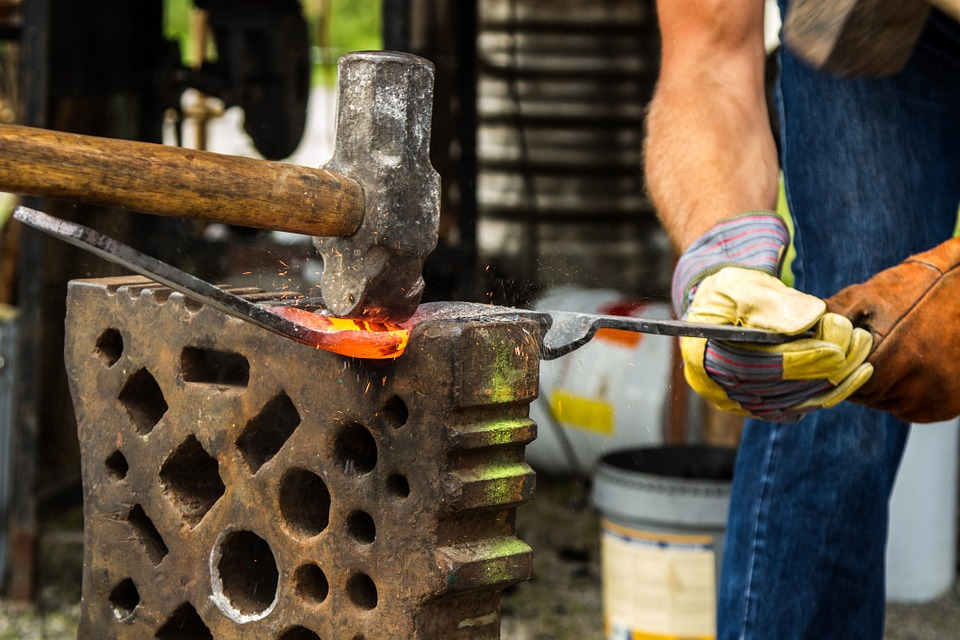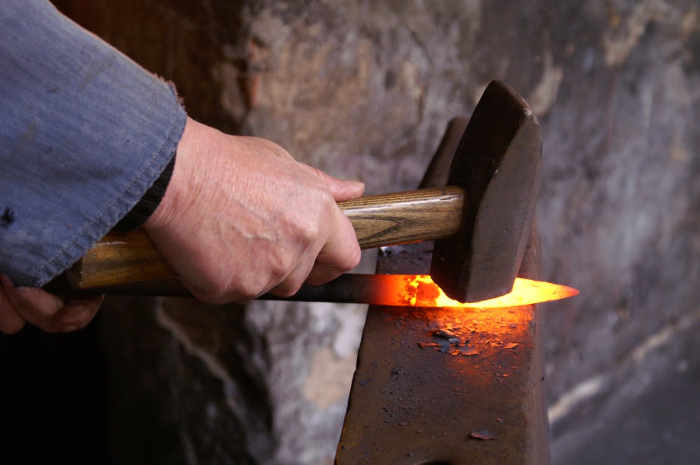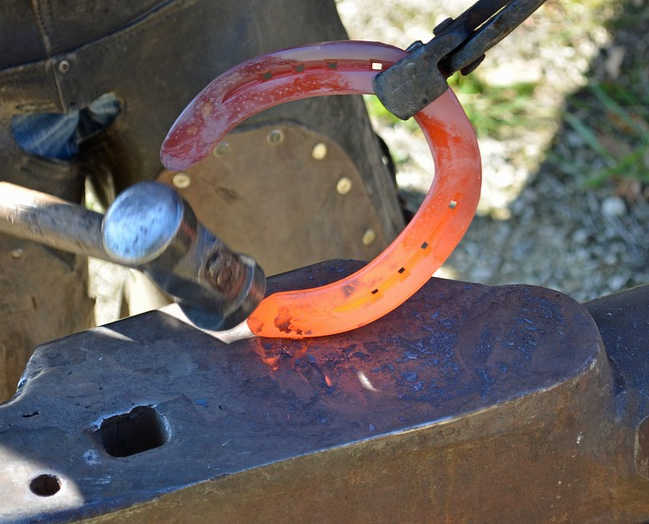No matter what kind of metal you’re trying to forge, the process is basically the same. You need to heat your metal to a specific temperature where it becomes easy to shape. But how do blacksmiths measure temperature and know when their metal is hot enough to work with?
How do blacksmiths measure the temperature of their forge or the steel they’re working with? In the old days, blacksmiths didn’t have thermometers and had to rely on the colors of their flames and metal to determine temperature. Modern blacksmiths use technology like infrared thermometers (aka pyrometers) and thermocouples to gain a more exact temperature reading of the forge and metals they’re working with.
Controlling temperature is critical in the forging of many metals. The temperature a piece is forged at will determine its structural and metallurgical properties. In this article, you’ll learn how blacksmiths measure temperatures, where they measure them, and what tools they use.
How A Blacksmith Measures The Temperature Of Their Forge And Metal
There are a few different methods and tools that a blacksmith uses to measure temperature.
By Eye
Until recent history, the majority of blacksmiths had to rely on the color of the steel that they were working with to give an approximate temperature.
Even with new technology available, I’d still recommend that a beginner blacksmith just learns the basic color to look for when working with their metal, as opposed to relying on fancy thermometers.

If you’ve ever seen a blacksmith at work, then you’ve seen steel glowing various shades of yellow, red, and orange. Each color corresponds with a different temperature of the metal.
- Steel begins to glow a dull red color at about 1100 degrees Fahrenheit (About 600 Celsius.)
- The red color increases in intensity until about 1500 F (800 C) when it reaches a bright red color.
- Then it starts to shift more to an orange color by the time it reaches 1700 F (925 C.)
- Finally, the color starts to change from orange to yellow. Around 2000 F (1100 C) steel glows bright yellow. Much above that temperature and steel will glow white hot and starts to melt at around 2500 F (1300 C.)
What color does my steel need to be before I can work it?
The temperature that you’ll need to get your steel up to really depends on what type of item you’re making and the task you’re doing.
- Tempering steel is normally done at temperatures between 450 F – 800 F. At these temperatures, steel changes to light straw, brown, purple, and blue colors.
- Forging and shaping is typically done at temperatures from 1400 F – 2000 F. And forge welding is done at temperatures above 2000 F.
Using An IR Thermometer (aka Pyrometer)
Modern blacksmiths can take advantage of new technologies to get a much more accurate idea of the temperatures they’re working with. IR thermometers or pyrometers are great for measuring high temperatures in a safe manner, since the devices don’t actually need to come into contact with the object you’re measuring.
The downside is that is can be hard to find pyrometers that work at higher temperatures, although they can be handy if you’re just tempering and not necessarily forging.
How Pyrometers Work
Every object emits infrared energy. The hotter an object is, the more IR energy it releases. Pyrometers can detect this energy and use it to determine temperature.
There are many different infrared technologies available for measuring various wavelengths and temperature ranges.
SW (Short-wavelength) – This type is recommended for measuring the temperature of steel, titanium, or copper while it’s inside a furnace. Because a furnace emits its own heat, it can throw off your ability to accurately measure the temperature of your metal with some other types of IR sensors.
LW (Long-wavelength) – These are usually the cheapest pyrometers you can find. They’re general purpose and can only really effectively measure temperatures below 200F (100 C.) For that reason they aren’t very useful to us as blacksmiths.
TC (Two-color) – This technology is good for steel or titanium, as long as it doesn’t have too much scale or surface oxidation.
DW (Dual-wavelength) – These are better for steel or titanium where significant amounts of surface oxidation or scale are present. They’re also more tolerant of optical obstructions and misalignment than TC technology.
MW (Multi-wavelength) – This is good for stainless steel, zinc, copper, and aluminum.

Using A Thermocouple
A thermocouple can withstand high temperatures and goes directly inside a furnace or kiln to let you know what temperature you’re working with.
If you’re using a thermocouple, you’ll also need a PID controller to give you a screen that displays the temperature.
What is a PID controller? It stands for proportional-integral-derivative controller. What the heck does that mean? Don’t worry about it… it’s all very sciency stuff you don’t need to know. All you care about is that it gives you control and consistency over your blacksmith furnace.
For a blacksmith’s furnace or forge you’ll most likely want to use a “K Type” thermocouple. This is the most common kind of thermocouple. They’re reliable, accurate, have a wide temperature range, and are relatively inexpensive. With a ceramic insulator, these should be able to withstand temperatures up to 2,300 F.
When Should A Blacksmith Measure Temperature?
Billet Temperature
It goes without saying that you’ll want to measure the temperature of your billet, or the big hunk of steel or iron that you’re working with. After all, the whole reason for using heat is to get your metal hot enough that you can easily work with it.
You’ll potentially want to measure your billet’s temperature inside of the furnace so that you know when it’s hot enough to begin working.
More importantly, you’ll want to keep note of what your steel’s temperature is like as you’re working with it. This is sometimes referred to as “in process temperature.” As it starts to cool down, you’ll find it gets harder to shape and manipulate, and you might need to put it back into your furnace to heat up again for a bit. A well heated piece of steel is easy to work with, but each strike can get more and more difficult as it starts to lose heat.
It’s best to let your steel cool for about 20 or 30 seconds after you take it out of the furnace before you check its temperature. If you’re using a square or rectangular piece of metal, the corners can actually heat faster and hotter than the rest of the metal, and about half a minute will be enough time for that to normalize.
Keeping your steel at the right temperature is critical when it comes to forging. If your piece gets too cool, it might crack while it’s being formed. This will weaken and deform whatever you’re making, causing it to wear prematurely later on.

In The Forge
You’ll want to know the temperature of your furnace or forge to make it easier to get your metal to the right temperature.
If you can get your forge to a consistent temperature, then there’s less need to measure the temperature of your steel once it comes out. Put your steel into a forge for long enough and it will get up to the same temperature.
Thermocouples are more commonly used to measure the temperature inside of forges, since they can give a continuous readout.
Conclusion
The easiest way to tell what temperature a piece of steel is at is simply by seeing what color it’s glowing. As steel begins to approach forging temperatures, it will start to glow red, then orange, and eventually yellow and white as it reaches higher and higher temperatures.
Tools like IR thermometers and thermocouples can be used to gain more precise temperature measurements.
Accurately controlling temperature at various parts of the forging process are critical to its success. Working with metal at the right temperature improves product quality, makes the process more efficient, and helps reduce scrap.
Related Questions
Q: Can I use any IR thermometer to measure the temperature of my forge and the metal I’m working with?
A: No. Most regular IR thermometers (aka pyrometers) don’t measure temperatures high enough for what we need to measure while blacksmithing. You’ll need to find a pyrometer specifically designed to measure higher temperatures. Ideally 2,000 F or hotter.
Q: What is quenching iron or steel and why do blacksmiths do it?
A: Quenching is rapidly cooling a piece of metal. This is usually done by immersing the hot piece of metal in oil or water. There are two reasons why blacksmiths quench their finished metal pieces. It hardens the steel and is the first part of heat treating a piece of metal before tempering it. Quenching also provides local cooling and prevents thinner pieces of the metal item from overheating or burning off.

